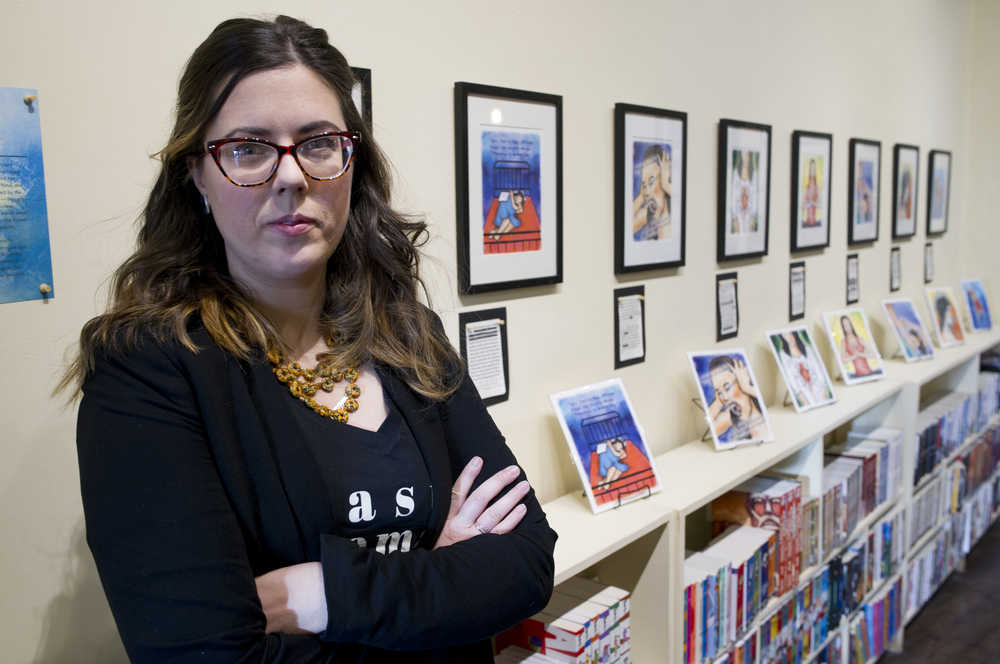“I think it’s powerful and addresses something that isn’t often talked about in public,” Lauren Brooks, a former advocate for Aiding Women in Abuse and Rape Emergencies (AWARE), said at the First Friday art display at Alaska Robotics of “Finding My Voice” by Christine Carpenter.
‘Powerful’ and ‘brave’ were words frequently used by people as they talked to Carpenter about her art — eight digital prints featuring a passage and a visual interpretation.
The passages came from the pages of her diary the week following her rape in Italy ten years ago.
The week after was a blur for her, she said, and she has a hard time remembering it. But as evidenced by her diary, she had a lot to say about what happened. It was only later that she became quiet about what happened, she said, and was surprised she had written what she did.
“It kind of struck me as odd too looking back on that week,” Carpenter said. “All I wanted to do was sleep. I didn’t have the ability to process. So when I did open up my diary, I was kind of taken back by what I had written too, and I kind of found it odd and strange.”
When she reread it, certain passages stuck out to her. She decided to reinterpret those passages through her art, a period which took a year and a half.
“It’s not about drawing something that is representative of something that is actually how I felt about it ten years ago, or even how I feel about it today, because I’ve been working on these … for a long time,” she said. “They are about interpreting what my emotions were at the time when I was doing them.”
Carpenter is a big believer in art therapy. Communicating her emotions isn’t something she’s good at, she said, but with art, she can turn her emotions into something visual. She wanted the passages with her art but didn’t want to damage her original diary, so she scanned the pages she wanted and then was able to digitally superimpose her written words on her artwork.
The eight pieces run through the stages of grief, she said. It starts off dark, an image of a man whose face is shadowed, the words from her diary “If I never see his face again it will be a day too soon” on it. It moves to a piece showing a woman lying on a bed, the passage reflecting her desire to sleep and block out the assault.
But the pictures become lighter and the words more hopeful and strong. One expresses a desire to heal in spirit, and another proclaims herself a warrior woman, while the last shows a woman dancing with the words “Yesterday’s girl is gone. I am a new woman, born again new.”
“Some of [the passages] don’t necessarily bring me comfort or joy or happiness, but they helped me process and go through a grieving process,” she explained.
She began considering doing a show at Alaska Robotics last summer, but it was only recently that she felt ready to do the show. Her fiancé encouraged her to do it, and she said eventually she found the courage.
“It’s taken me a while to get to this place,” she said.
Carpenter, who works as an exhibition developer and was a graphic designer at the Juneau Empire and Capital City Weekly a few years ago, is no stranger to art displays. But outside of student shows when she was in college, she had never done a solo exhibition. This would be her first time as the artist on display, and for a first time, the art is deeply personal.
“I’m a designer also and one of my favorite distinctions between design and art has been ‘Design you create for somebody else and with art you do for yourself,’” she said a few days before the show, going on to say she wasn’t sure if the pieces would resonate with others or not. “If they do that’s great and if they don’t that’s okay because these are pieces that have helped me cope with what I felt. That’s all they’re meant to do. I’m only sharing them because it’s a way of sharing my story and there is a sense of freedom that comes from sharing a story,” she said.
For the show, she rewrote pages of her journal on the extra blanks ones she found in the back as to not damage the original; then she crossed out all the other lines save the passages featured in the art. Each corresponding page went by its piece. She also put up prints of her work for sale if a piece truly resonated with someone, as well as cards.
The art show is about displaying her work, she said, but it’s also about spreading awareness about rape and sexual assault. She even had a donation box set up for AWARE.
She described the show as “a coming out party” since a lot of people didn’t know that the sexual assault happened to her.
“I didn’t know how to address it. I knew that I would have found some freedom if I had shared this story. I think I started this show knowing full well that it would be that for me.”
The art will be up through the month of January.

